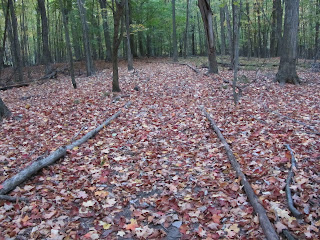Saturday was a good day at Forest Hill for a hike with my dog, Remi. The early morning weather was partly sunny with a temperature of 34 degrees and no wind. Descending the hill, I had to sidestep a few Muskrat holes on the berm next to Mallard Marsh. I walked through Bobolink Meadow and came to the entrance of North Woods where I scared up five deer. Entering the woods, I noticed lots of American Beech trees with their smooth, gray bark and distinctive leaves. The harvested timber from this tree is used for rough lumber, flooring, plywood, and railroad ties. Beech wood is also used to make tool handles, baskets, veneer, and novelty items. The soft, reddish tinge of the wood makes it desirable for furniture. Also, I spotted a few leaves remaining on a Chinquapin Oak tree. I exited the woods and followed the trail to the far west side of Succession Field where I saw a few leaves left on a Red Oak tree. Native Americans used Red Oak bark for dysentery and chewed it to treat mouth sores; an infusion was taken to treat asthma. The wood was also used to make baskets, cooking tools and building materials. Colonists used Red Oak for firewood and to make woven chair bottoms and cooking tools. Leaves were used to wrap dough for bread making. Further along, I saw a few leaves still clinging to a large Pin Oak tree and a small White Oak tree. Native Americans boiled White Oak tree bark and drank the resulting liquid to curb diarrhea and to relieve the effects of bleeding hemorrhoids. White oak tree products helped induce vomiting, reduce fevers and served as antiseptics. I kept going and entered South Woods where I observed the dark scaly bark of a Black Cherry tree and the muscle-like bark of a Muscle Wood tree. Exiting the woods, I came to Artist Overlook where I was amazed a few days ago to see approximately a hundred ducks of unknown species erupting from Sora Swale. Next, I followed south trail where I noticed all the white berries were gone from a Gray Dogwood tree and all that remained were tiny red twigs. Further along, I saw a small Weeping Willow tree with a few leaves left on it. Some Native American tribes would lay willow limbs in the marriage beds of newly married couples in hopes that they would help ensure immediate fertility. They also made gifts from both the limbs and the bark of willows and presented them to brides on their wedding day as a symbol of their blessing upon the union. Continuing on south trail, I turned north at Frog Fen and climbed up Reflection Hill to gaze down on Grebe Pond where I spotted lots of swimming geese. Descending the hill, I crossed the boardwalk and noticed most leaves on a Black Willow tree were turning yellow. Finally, we passed the Classroom Building, came to the van and left for home.
October winds blow even stronger
Days are shorter. Nights are longer
Clouds are thick. Air is cold
Seasons are changing. Truth be told
North Woods is quite a sight
Displays of color in morning light
I look to trees above my head
Leaves of orange, yellow and red
Oak, maple, elm and beech
Colorful leaves out of reach
I look to the ground below my feet
Carpet of color is almost complete
A nature hike in the autumn chill
Sparkling frost covers the hill
I look all around this land
The fall vista is really grand
D. DeGraaf



